

 Vol. 39 (# 21) Year 2018. Page 15
Vol. 39 (# 21) Year 2018. Page 15
Adlet Dyusembaevich KARIYEV 1; , Aiman Toktacinovna SELKEBAYEVA 2; Guliya Kabenovna BESPAYEVA 3; Baglan Imangalievna BAIGUNDINOVA 4; Almira Gauhatovna KABDUALIEVA 5
Received: 29/11/2017 • Approved: 0102/2018
ABSTRACT: The paper offers the results of an empirical study of teacher's willingness to train by interactive methods as a condition for the development of creative abilities. Based on the analysis of psycho-pedagogical literature, the definition of the concept of "teacher's willingness to teach by interactive methods as a condition for the development of students’ creative abilities" was given. Using the system analysis, the authors presented the structure of teacher's readiness for training by interactive methods as a condition for the development of students’ creative abilities. The motivational, content-based and procedural components were singled out in the structure of the desired readiness; some criteria, indicators, research methods and levels were presented. The motivational component reflects the teacher’s professional orientation and the professional perspective of the object of a holistic pedagogical process (HPP); the content-based component involves the teacher's knowledge of the HPP theory and the knowledge of the object of teacher’s professional activity; the procedural component reveals the teacher's ability to predict pedagogical activity taking into account the possibilities of using interactive methods and the ability to introduce interactive methods into pedagogical reality. With the help of diagnosable techniques, the results of an empirical study of teacher's readiness for training by interactive methods as a condition for the development of creative abilities are proposed. |
RESUMEN: El articulo ofrece los resultados de una investigción empírica acerca de la voluntad del docente de capacitarse mediante métodos interactivos como condición para el desarrollo de habilidades creativas. Con base en el análisis de la literatura psicopedagógica, se dio la definición del concepto de "voluntad del docente de enseñar por métodos interactivos como condición para el desarrollo de las capacidades creativas de los estudiantes". Usando el análisis del sistema, los autores presentaron la estructura de la preparación del maestro para el entrenamiento mediante métodos interactivos como una condición para el desarrollo de las habilidades creativas de los estudiantes. Los componentes motivacionales, basados en el contenido y los procedimientos se seleccionaron en la estructura de la disposición deseada; se presentaron algunos criterios, indicadores, métodos de investigación y niveles. El componente motivacional refleja la orientación profesional del docente y la perspectiva profesional del objeto de un proceso pedagógico holístico (HPP); el componente basado en el contenido implica el conocimiento del profesor de la teoría de la HPP y el conocimiento del objeto de la actividad profesional del docente; el componente de procedimiento revela la capacidad del profesor de predecir la actividad pedagógica teniendo en cuenta las posibilidades de utilizar métodos interactivos y la capacidad de introducir métodos interactivos en la realidad pedagógica. Con la ayuda de técnicas diagnosticables, se proponen los resultados de un estudio empírico de la preparación del maestro para el entrenamiento por métodos interactivos como condición para el desarrollo de habilidades creativas. |
In the context of globalization and informatization of modern society, it is no longer sufficient for fruitful activity to have only a high level of competence in one area or another. In connection with this, new requirements to the content and results of teacher’s professional activity are imposed by the education of the 21st century. If previously the main goal of education in the general education system was the accumulation of a certain amount of knowledge, now it is the development of the ability of a creative approach to the solution of certain tasks. This trend is related to the fact that the progress of science and technology in society requires the development of a new style of social behavior and creative thinking. The main value of education is forming a person’s need and ability to go beyond the studied, the skills of continuous and flexible self-development throughout life.
The theoretical analysis of scientific literature shows that the fundamentals of the concept of "teacher’s readiness for professional work" in its various aspects have been studied in sufficient volume by scientists. However, the problem of teacher's readiness to train by interactive methods as a condition for the development of students’ creative abilities has not been sufficiently studied in pedagogical science and the theory of education, and has not been a subject of a special study. There is no detailed definition in books of the very concept of "teacher's readiness to learn by interactive methods as a condition for the development of students’ creative abilities" although there are a lot of works about teacher's readiness for professional activity.
These circumstances require the solution of theoretical and practical issues that are related to the interpretation of the very concept of "teacher's willingness to train by interactive methods as a condition for developing students’ creative abilities". It is particularly important to determine the internal content of teacher's willingness to train by interactive methods as a condition for developing students’ creative abilities and learning it in practice.
At present, the problem of teacher's readiness to train by interactive teaching methods is relevant. The problem of using interactive teaching methods is considered in the thesis works of B.D. Hajiyeva, G.S. Kharkanova, N.V. Solodyuk, and S.A. Bizyayeva. M.B. Mukasheva, E.V. Ponomarenko, R.S. Rafikova, E.V. Elnikova, A.P. Panfilova, I.S. Peshnya, and I.A. Chernykh have studied the issues of interactive training and the use of interactive technologies in the learning process.
In psychological and pedagogical literature, interactive methods describe the training methods carried out through the interaction of students during the process of education. They allow gaining new knowledge on the basis of the personal contribution to the common cause of each of the participants in the process of education. In interactive techniques, students teach each other; their distinctive feature is their dialogue nature.
N. Suvorova believes that "interactive" means able to interact or being in the mode of conversation, dialogue with something (computer) or with someone (person) (Suvorova 2000, p. 25).
Interactive methods contribute to the intensification of the process of education. According to Ioffe A.N., the Russian scientist, the use of interactive methods enables students to:
Teacher's readiness for training by interactive methods as a condition for developing students’ creative abilities is one of the important aspects of teacher's professional training. Therefore, to identify the essence of this concept, it is necessary to refer to the theory of professional pedagogical education. Kazakhstan has accumulated experience in researching the professional training of teachers.
Some Kazakhstan scientists such as N.D. Khmel, N.N. Khan, R.M. Duzbaeva, S. Begaliyeva, B.K. Tulbasova, E.P. Nechitailova, E.K. Kustobaeva, L.V. Nikitenkova, L.A. Ivakhnova, A.A. Kalyuzhny, K.S. Uspanov, A.K. Rysbaeva, S.S. Zhumasheva, S.V. Fateev, A.N. Suleimenova, N.A. Neustroeva and others made a great contribution to the development of the problem of improving professional pedagogical training.
Works of V.A. Slastenin, a famous scientist, are devoted to the problems of teacher's professional training, and in particular, his/her readiness for teaching. He thinks, like other authors, that a special psychological state is meant by the readiness for pedagogical activity, and he includes two interrelated structural components in it: motivational – value-based (personal) and performing (procedural) (Slastenin, 1981).
Questions of the theory of teacher training are investigated by N.D. Khmel. She justifies the connection between teacher's professionalism and the knowledge of the features of the object of his/her activity – a coherent pedagogical process, the essence of the pedagogical process, its integrative qualities and properties; the components are described, the patterns are revealed, the structure of this process, its driving forces and educational mechanisms are shown, the analysis of the main characteristics of the pedagogical process is given, methods for selecting information for managing its state are justified.
Khmel N.D. believes that "the goal of professional training and its result indicates that every person who is mastering a profession faces three of its aspects — substantive, personal and procedural (technological). There are some tasks that we solve during our professional training. They are related to what a specialist should know by his functions, how he would apply this knowledge to his professional activity, what qualities a person should acquire, so that knowledge and skills will give the maximum result" (Khmel, 1998, p. 10). According to N.D. Khmel, the structure of pedagogical education as a whole reflects the idea of what to teach a future teacher – to give good general-purpose training, to form the foundation of knowledge in the specialty and psychological and pedagogical disciplines. However, the scientist notes that today such training is not enough, since the role of the teacher in developing the work methods of students and personality of a person has significantly changed. Therefore, "...the content-based, personal and professional aspects should be combined with the technology of teachers' work, the ability of the teacher to see the general and the particular in his/her organizational and functional activities" (Khmel, 2008, p. 54). The main thing in the interconnection of these three aspects of the professional training of teachers belongs to the mastery of pedagogical theory, reflecting the object of its activity – a holistic pedagogical process (HPP). We understand HPP as the process of purposeful interaction of children in the assimilation of cultural wealth accumulated by previous generations and their active participation in public life, which takes place under the guidance and with the direct participation of the teacher. A person can form pedagogical skills by knowledge of pedagogical theory.
E.N. Pehota and A.M. Stareva singled out the following components of professional-pedagogical training of a teacher:
The theoretical analysis of studies on the issues of teacher training and teacher’s readiness for teaching allows concluding that this is a complex formation, formed under the influence of special training and own experience of activity. We consider it is necessary to note that it is possible to form readiness for pedagogical activity only in the process of professional training. Training is a process, and readiness is, on the one hand, a goal, and the result of this process, on the other hand.
Thus, teacher's willingness to teach by interactive methods as a condition for developing students’ creative abilities is a complex personality-professional education consisting of some elements that include an individual’s professionally significant qualities, special knowledge, skills and abilities that ensure the development of students’ creative abilities.
An integral part of our study is to determine the structure of teacher's readiness for training by interactive methods as a condition for developing students’ creative abilities. With the help of the system-oriented analysis, we determined the structure of teacher's readiness for teaching by interactive methods as a condition for the development of students’ creative abilities, which was presented in Scheme 1.
In M. Skiboy's opinion, structural and functional analysis makes it possible to present readiness for pedagogical activity as a system, that is, as a set of interacting elements, having some sort of ordering and possessing a relatively stable unity that is characterized by internal integrity, expressed in relative autonomy behavior or existence (Skiba 2001).
Scheme 1
Structure of teacher's readiness for training by interactive methods
as a condition for developing students’ creative abilities
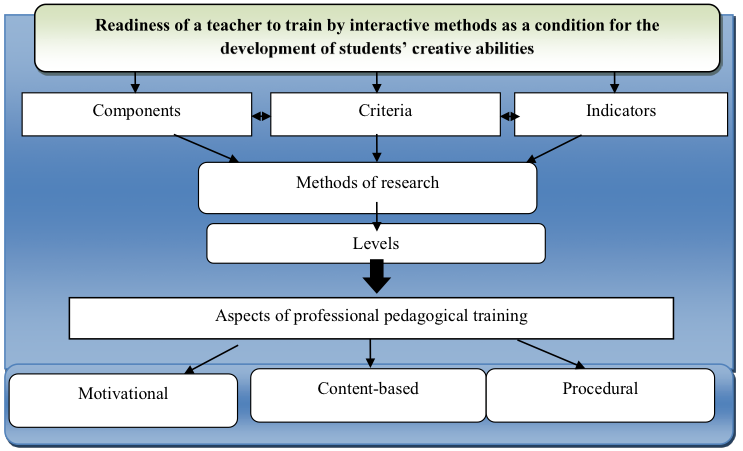
When developing teacher's readiness for training by interactive methods as a condition for developing students’ creative abilities, we relied on:
Thus, teacher's willingness to train by interactive methods is the basis for developing students’ creative abilities. In its structure, we distinguish the following components: motivational, content-based, procedural.
In turn, the motivational component reflects the teacher’s professional orientation and the professional vision of the object of the HPP.
The content-based component is the teacher's knowledge of the HPP theory and the knowledge of the object of the professional activity of the teacher.
The ability of the teacher to predict pedagogical activity, taking into account the possibilities of using interactive methods and the ability to introduce interactive methods into pedagogical reality, is reflected in the procedural component of the desired readiness.
The study and analysis of teacher's readiness for training by interactive methods as a condition for the development of students’ creative abilities made it possible to determine its criteria, indicators and research methods (listed in Table 1).
Based on the set of indicators, we assumed the availability of possible levels of readiness, in which there is a different correlation of criteria and indicators: high, medium, low.
Table 1
Components, criteria, and indicators of teacher's readiness to train by interactive
methods as a condition for the development of students’ creative abilities
Components |
Criteria |
Indicators |
Methods |
1 |
2 |
3 |
4 |
Motivational |
The professional orientation of the teacher |
the positive attitude of the teacher towards the introduction of new pedagogical technologies into his work |
Questionnaire
|
conviction of the need to use interactive methods for developing students’ creative abilities |
|||
Professional vision of the facility
|
interest in improving the ability to use interactive teaching methods |
Conversation
Questionnaire
|
|
awareness of the teacher about the development of new pedagogical technologies |
|||
Content-based |
Knowledge of the object of professional activity of the teacher |
knowledge of the theory of HPP |
Test of achievements
|
knowledge of the importance of placement of a student to the position of the subject of training |
|||
Knowledge of the theoretical foundations of interactive methods |
knowledge of the essence of the concept of "interactive teaching methods" |
Questionnaire
Survey |
|
knowledge of the types of interactive teaching methods that develop students’ creative abilities |
|||
Procedural |
The ability to predict pedagogical activity with opportunities for using interactive methods |
the ability to determine topics in the content of the taught subject that can be studied through the use of interactive teaching methods |
Questionnaire
|
the ability to choose and use different types of interactive methods that develop students’ creative abilities |
|||
The ability to introduce interactive methods into pedagogical reality |
the ability to apply interactive teaching methods in the traditional educational process |
Monitoring
|
|
the ability to follow the development of students’ creative abilities using interactive teaching methods |
The high level is characterized by the teacher's positive attitude toward the introduction of new pedagogical technologies into his/her work. He/she is convinced of the need to use interactive methods that develop students’ creative abilities. The teacher is aware of the area of development of new pedagogical technologies and is interested in improving the ability to use interactive teaching methods. He/she has profound knowledge of the theory of the HPP, the essence of the concept of "interactive teaching methods" and the types of interactive teaching methods that develop students’ creative abilities. He/she understands that in the pedagogical process the teacher and student are subjects of activity. The teacher can determine the content of the subject taught, and topics that can be studied through the use of interactive teaching methods. He/she can apply interactive teaching methods in the traditional educational process and monitor the development of students’ creative abilities using interactive teaching methods.
The average level is characterized by the following things: the teacher has positive attitude towards introducing new pedagogical technologies into his/her work. He/she is convinced of the need to use interactive teaching methods that develop students’ creative abilities but believes that it is enough to use interactive teaching methods from time to time in their lessons. He/she has sufficient knowledge about the theory of HPP, about the essence of the concept of "interactive teaching methods" and about the types of interactive teaching methods that develop students’ creative abilities. The teacher is aware of the development of new pedagogical technologies. It is not important for him/her to improve the ability to use interactive teaching methods. The teacher can determine topics in the content of the subject taught, which can be studied through the use of interactive teaching methods, but it is difficult to apply interactive methods in the traditional educational process and to monitor the development of students’ creative abilities using interactive teaching methods.
The low level is characterized by the teacher's lack of positive attitude towards the introduction of new pedagogical technologies into his work. He/she does not need the use of interactive teaching methods that develop students’ creative abilities. The teacher has superficial knowledge of the theory of HPP, the sphere of development of new pedagogical technologies, the essence of the concept of "interactive teaching methods" and the types of interactive teaching methods that develop students’ creative abilities. The teacher does not consider it important to improve the ability to use interactive teaching methods. The teacher does not know how to define topics in the content of the subject taught, which can be studied through the use of interactive teaching methods. He/she finds it difficult to apply interactive methods in the traditional educational process and monitor the development of students’ creative abilities using interactive teaching methods.
The formed levels of teacher's readiness for training by interactive methods that promote the development of students’ creative abilities do not cover the whole variety of manifestations of the characteristics of this integrative education. Researchers also distinguish evaluative, situational, sufficient and other levels of various aspects of teacher training.
A visual representation of the distribution of the signs of the desired readiness is presented in Table 2.
Table 2
Distribution of levels of signs of teacher's readiness for training by interactive
methods as a condition for the development of students’ creative abilities
No. |
Signs of readiness |
Levels |
||
High |
Average |
Low |
||
1 |
2 |
3 |
4 |
5 |
1 |
Positive attitude of the teacher to the introduction of new pedagogical technologies into his work |
+ |
+ |
– |
2 |
Conviction of the need to use interactive methods for developing students’ creative abilities |
+ |
+ – |
– |
3 |
Interest in improving the ability to use interactive teaching methods |
+ |
– |
– |
4 |
Awareness of the teacher about the development of new pedagogical technologies |
+ |
+ |
+ – |
5 |
Knowledge of the HPP theory |
+ |
+ – |
+ – |
6 |
Knowledge of the importance of the student's withdrawal to the position of the subject of training |
+ |
+ – |
– |
7 |
Knowledge of the essence of the concept of "interactive teaching methods" |
+ |
+ – |
+ – |
8 |
Knowledge of the types of interactive teaching methods that develop students’ creative abilities |
+ |
+ – |
– |
9 |
The ability to determine topics in the content of the taught subject that can be studied through the use of interactive teaching methods |
+ |
+ |
– |
10 |
Ability to choose and use different types of interactive methods that develop students’ creative abilities |
+ |
+ |
– |
11 |
The ability to apply interactive teaching methods in the traditional educational process |
+ |
+ – |
– |
12 |
Ability to follow the development of students’ creative abilities using interactive teaching methods |
+ |
+ |
– |
Thus, we assume that teacher's willingness to train by interactive methods that are a condition for developing students’ creative abilities is an important aspect of his/her professional training. The developed model of the desired readiness, components, criteria, indicators and methods of research, tentative levels of its formation are the basis for conducting summative, formative, and control assessments.
An empirical study of teacher's readiness for training by interactive methods as a condition for the development of students’ creative abilities was conducted on the basis of secondary schools No. 60, No. 68, No. 130 of Almaty city, the University of Almaty ( Almaty, Kazakhstan), Priamur State University named after Sholom-Aleikhem (Birobidzhan, Russia) and the Kazakhstan Innovation University (Almaty Families, Kazakhstan) in 2016-2017 academic year.
33 intermediate teachers, whose work experience did not exceed seven years, and 67 third-year and fourth-year students qualified in "Pedagogics and Methods of Primary Education" and "Pedagogics and Psychology" were involved in the survey.
To study the attitude of teachers to the introduction of new pedagogical technologies into their activities, we analyzed the answers to the question "How do you feel about introducing new pedagogical technologies into your activity?" The obtained information allowed grouping the following databank:
32% of respondents answered: "Positively, I consider it necessary to apply pedagogical technologies in modern pedagogical reality";
48% of respondents answered: "I am convinced that it is necessary, but I do not consider the introduction of new pedagogical technologies to be significant in my activity";
20% of respondents ido not consider it necessary to use new pedagogical technologies in their activities (see Figure 1).
Figure 1
The attitude of teachers to the use of new pedagogical technologies

To study the knowledge of teachers and third-year and fourth-year students about new pedagogical technologies, common in teaching practice, we conducted a questionnaire study. So in the answers such concepts as teaching methods, modes of study and pedagogical technologies are confused:
The received answers allow considering that the majority of respondents confuse pedagogical technologies and innovative methods of training.
One of the important signs of teacher's readiness to use interactive teaching methods is the knowledge of the essence of the concept of "interactive teaching methods". To this end, participants were asked the following question: "How do you understand the essence of interactive teaching methods?" The results of the survey are as follows:
Figure 2
Understanding the essence of the concept
of "interactive teaching methods"
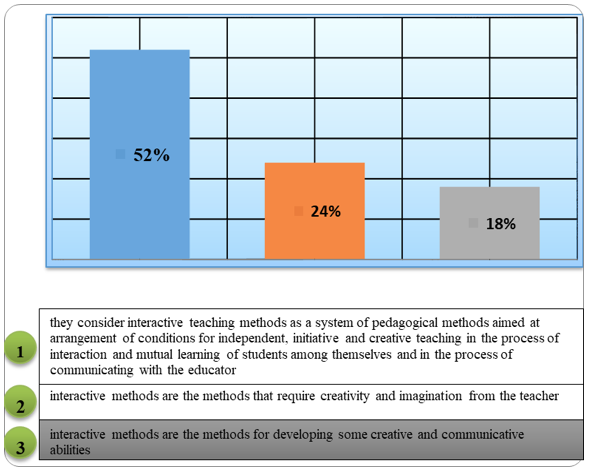
Summarizing the above, we can conclude that the majority of participants in the study correctly understand the nature of interactive teaching methods.
The process of forming teacher's willingness to use interactive teaching methods is influenced by the teacher's interest in mastering the methodology of using interactive teaching methods. Therefore, we asked the respondents the following question: "Are you interested in mastering the methodology of using interactive teaching methods?" The results were as follows: 27 people (27%) took an active interest in mastering the methods of using interactive methods of teaching; 56 people (56%) were interested in applying the methods of using interactive teaching methods ad hoc, and 17 people (17 %) showed no interest in mastering the methods of using interactive methods of teaching (see Figure 3).
Figure 3
Interest in mastering the methodology of using interactive teaching methods
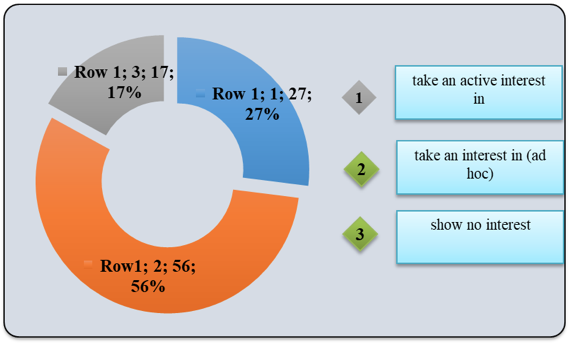
To identify the knowledge of teachers about the importance of bringing the student to the position of the subject of training, we asked: "Do you think that there is a need in the process of learning to replace the teacher-student relationship from "subject-object" to "subject-subject" relationship?". After analyzing the answers of the respondents, we came to the following conclusion:
24% of respondents considered it important to restructure the relations between the teacher and the student in the process of learning from "subject-object" to "subject-subject" relationships;
55% of respondents were convinced that it was necessary, but they did not consider it important to replace the relations between the teacher and the student in the process of learning from "subject-object" to "subject-subject" relations;
21% of respondents did not consider it necessary to replace the relations between the teacher and the student in the process of learning from "subject-object" to "subject-subject" relationships (see Figure 4).
Figure 4
Results of respondents' answers to the question "Do you think that there is a
need for the learning process to change the teacher-student relationship from
"subject-object" to "subject-subject" relationship?"
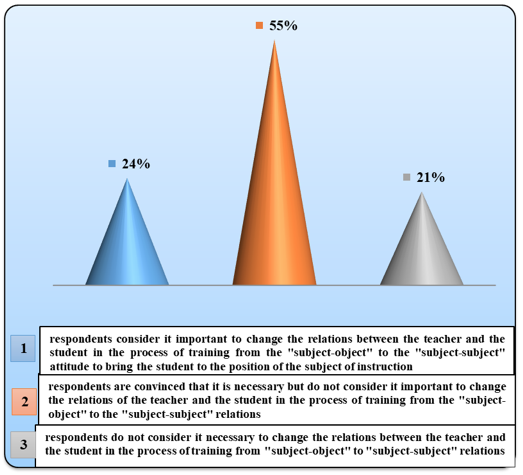
We received the following answers to the question: "Do you think interactive teaching methods develop schoolchildren’s creative abilities?"
Figure 5
Ability to develop schoolchildren’s creative abilities when
using interactive methods in the learning process
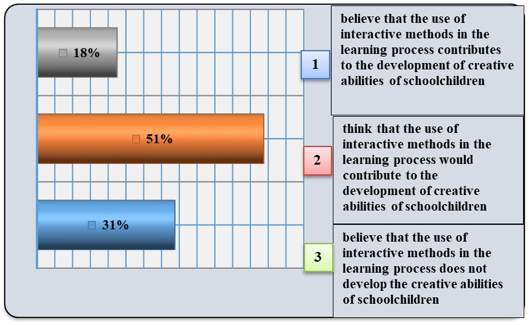
The next question is asked to determine the level of use of interactive methods of teaching by respondents in practice. The results of the questionnaire study are as follows: 15% of respondents have a high level of use of interactive methods, 37% sufficient level of use of interactive methods and 48% of respondents have a low level of use of interactive methods (Figure 6).
Figure 6
Levels of use of interactive teaching methods
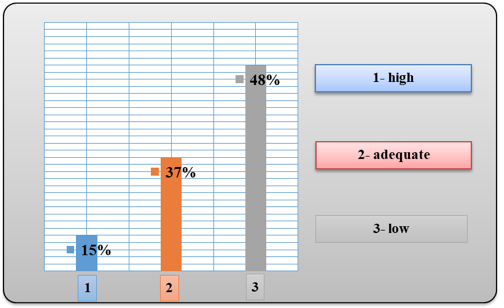
We have analyzed the answers of the participants to the questions "What interactive methods of teaching did you try to use in your activity in combination with traditional methods? (please, specify them)"," What do you think, in the teaching of what subjects and topics can you use interactive teaching methods? (please, specify them)": mainly the participants believe that interactive teaching methods can be used in teaching humanities in any subject, and interactive methods such as working in small groups, working in pairs, role-playing game, the discussion can be applied to their activities in conjunction with traditional methods of teaching.
To determine how often teachers and third-year and fourth-year students use interactive teaching methods in their activities, we proposed a questionnaire. For this purpose, the participants in the study were invited to note those interactive methods that they apply in pedagogical activity by categories: often, rarely, never. The results were ranked and presented in Table 3.
Table 3
Results of ranking by participants of the study
No |
Interactive methods |
Often |
Rarely |
Never |
|||
Number of elections |
Rank Place |
Number of elections |
Rank Place |
Number of elections |
Rank Place |
||
1. |
Working in small groups |
25 |
2 |
13 |
8 |
6 |
7 |
2. |
Working in pairs |
34 |
1 |
21 |
4 |
7 |
5 |
3. |
Brainstorming |
0 |
12 |
3 |
12 |
24 |
2 |
4. |
Role-playing game |
16 |
3 |
26 |
2 |
2 |
11 |
5. |
Business game |
6 |
6 |
12 |
9 |
6 |
7 |
6. |
Cinquain |
3 |
9 |
16 |
7 |
7 |
4 |
7. |
Cluster |
3 |
9 |
19 |
6 |
1 |
13 |
8. |
Discussion |
12 |
5 |
24 |
3 |
3 |
10 |
9. |
Project method |
15 |
4 |
27 |
1 |
2 |
11 |
10. |
Creative tasks |
4 |
8 |
21 |
4 |
6 |
7 |
11. |
Inviting experts |
0 |
12 |
1 |
12 |
26 |
1 |
12. |
KWL technique (what we Know, what we Want to know and what we Learned) |
5 |
7 |
6 |
10 |
23 |
3 |
13. |
Case method |
1 |
11 |
5 |
11 |
22 |
4 |
According to the results of the ranking, it is evident that respondents use in practice such interactive methods of teaching as working in pairs, working in small groups, role play, and project method.
One of the criteria for teacher's willingness to use interactive teaching methods is the knowledge of the HPP theory. Using the test of achievements in the theory of HPP, teachers, and students of the 3rd and 4th year were tested to determine the level of knowledge of the theory of the HPP. The analysis of the results revealed the following:
So, the results of the empirical study showed a low level of readiness of teachers and students of the 3-4 courses to use interactive methods of teaching in pedagogical activity. It should be noted that the participants of the study have an interest in mastering the methodology of using interactive teaching methods, which is one of the important conditions for the teacher's readiness to use interactive teaching methods. Thus, the obtained results of the empirical research will help to develop an effective model of teacher's readiness to use interactive teaching methods.
The study of the theory of teacher's readiness for training by interactive methods as a condition for the development of students’ creative abilities and the results of experimental work allowed drawing some conclusions:
We described the importance of interactive methods in the preparation of future teachers, in the educational process of educational institutions. We have analyzed approaches regarding the concepts of "readiness", "teacher's readiness for professional activity", and "teacher's readiness to train by interactive methods as a condition for developing students’ creative abilities".
Teacher’s readiness for training by interactive methods as a condition for the development of students’ creative abilities is defined as a complex personal and professional education consisting of some elements that include professionally significant qualities of the individual, special knowledge, skills and abilities that ensure the development of students’ creative abilities.
Based on this definition, the following structural components of the desired readiness are distinguished: motivational, content-based, procedural.
In turn, the motivational component reflects the professional orientation of the teacher and the professional vision of the object of HPP.
The content-based component is the teacher's knowledge of the HPP theory and the knowledge of the object of the professional activity of the teacher.
The ability of the teacher to predict pedagogical activity, taking into account the possibilities of using interactive methods and the ability to introduce interactive methods into pedagogical reality, is reflected in the procedural component of the desired readiness.
The teacher's positive attitude towards the introduction of new pedagogical technologies into his/her work, persuasion of the necessity of using interactive methods for the development of students’ creative abilities, an interest in improving the ability to use interactive teaching methods, and the teacher's awareness of the development of new pedagogical technologies are the indicators of the motivational component of the desired readiness. The content-based component is determined by the knowledge of the HPP theory and the knowledge of the essence of the concept of "interactive teaching methods". The procedural component is characterized by the ability to determine topics in the content of the taught subject that can be studied through the use of interactive teaching methods, as well as the ability to select and use different types of interactive methods that develop students’ creative abilities.
Based on a set of indicators of teacher’s readiness for training by interactive methods as a condition for developing trainees’ creative abilities, some levels of readiness are proposed, where a different ratio of criteria and indicators are noted: high, medium, low.
An empirical study of teachers, second-year, and third-year students was carried out about the identification of readiness for training by interactive methods as a condition for the development of students’ creative abilities. The results of the study allowed concluding on the need for specially organized training of future teachers for training of students by interactive teaching methods.
The possibilities of the pedagogical process of the university on the formation of the teacher's readiness for training by interactive methods as a condition for the development of students’ creative abilities were revealed.
Ioffe, A.N. (2000). Aktivnaya metodika – zalog uspekha [Active methodology Is the Key to Success]. In Grazhdanskoe obrazovanie. Material mezhdunarodnogo proekta [Civic Education. The Information Data of the International Project]. Saint Petersburg. (p. 144).
Khmel, N.D. (1998). Teoreticheskie osnovy professionalnoi podgotovki uchitelya [The Theory for Teacher Training]. Almaty: Gylym. (p. 320).
Khmel, N.D. (2008). Teoriya i tekhnologiya realizatsii tselostnogo pedagogicheskogo protsessa: uchebnoe posobie v pomoshch prepodavatelyam, aspirantam, magistrantam, studentam [Theory and Technology of the Implementation of a Coherent Pedagogical Process: Teaching Aid to Help Teachers, Graduate Students, Undergraduates, Students] (2nd ed. revised and enlarged). Almaty: Abai Kazakh National Pedagogical University. (p. 176).
Pjehota, O.M., & Starjeva, A.M. (2005). Osobystisno orijentovane navchannja: pidgotovka vchytelja: Monografija [Student Oriented Learning: Preparing Teachers: Monograph]. Mykolaiv: Vid-vo "Іlіon". (p. 272).
Skiba, M.A. (2001). Metodika formirovaniya gotovnosti budushchikh uchiteley k otboru soderzhaniya matematicheskogo obrazovaniya v usloviyakh differentsiatsii shkol: Avtoref. … kand. ped. nauk [The Methodology for Forming the Readiness of Future Teachers to Select the Content of Mathematical Education in Conditions of Differentiation of Schools (Ph.D. Thesis Abstract)]. Almaty. (p. 26).
Slastenin, V.A. (1981). Professionalnaya gotovnost uchitelya k vospitatelnoy rabote [Professional Readiness of a Teacher for Educational Work]. Sovetskaya pedagogika, 4, 76-84.
Suvorova, N. (2000). Interaktivnoe obuchenie: Novye podkhody [Interactive Training: New Approaches]. Uchitel, 1, 25-28.
1. Amur State University named for Sholom-Aleichem, 679015, Russia, Jewish Autonomous Region, Birobidzhan, Shirokaya St., 70a
2. Almaty University, 050007, Kazakhstan, Almaty, Aksai 3-th micro-district, B. Momyshuly 36
3. Kazakhstan Innovative University, 071400, Semey, Kazakhstan, str. Bayseitov 5
4. Kazakhstan Innovative University, 071400, Semey, Kazakhstan, str. Bayseitov 5
5. Kazakhstan Innovative University, 071400, Semey, Kazakhstan, str. Bayseitov 5